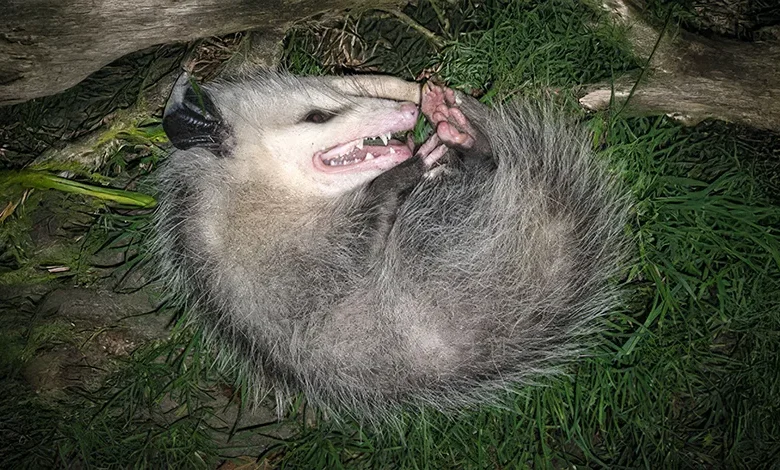Manicou – Opossum

Manicou is a small mammal native to Dominica. Known scientifically as the common opossum (Didelphis marsupialis), the Manicou thrives in rainforests of Dominica and wetland areas, contributing significantly to the island’s biodiversity. This nocturnal animal is frequently found near rivers and dense forest cover within protected areas such as the Central Forest Reserve and Morne Trois Pitons National Park.
Manicou – Opossum Habitat and Distribution
The Manicou – Opossum are well adapted to forests in Dominica’s interior, particularly around Pont Cassé, where rainfall and vegetation are abundant. They inhabit lowland rainforests and other lush environments where food sources and cover are plentiful, allowing them to thrive in Dominica’s natural landscapes.
In addition to thriving in dense forests, Manicous are frequently seen along riverbanks. Rivers such as the Manicou River, Melville Hall River, and Layou River in Dominica’s interior offer essential water sources, supporting the species’ survival and well-being. The Melville Hall – Portsmouth Road, Layou Valley Road, Valley Road and nearby forest areas often have high sightings of Manicous due to the intersection of natural habitats with human transportation routes.
Physical Characteristics
The Manicou – Opossum are medium-sized marsupials, typically weighing between 2 to 4 kilograms. They possess a prehensile tail, which aids in climbing and navigating through trees. Their fur is generally grayish-brown, offering effective camouflage against the forest backdrop. Adaptations such as sharp claws and strong limbs enable them to move swiftly through their arboreal habitats.
Diet and Foraging Behavior
Manicou – Opossum are omnivorous, with a diet that includes a variety of fruits, insects, small vertebrates, and plant matter. Their foraging activities play a crucial role in seed dispersal, aiding in forest regeneration and maintaining plant diversity. Key components of their diet include:
- Mammee Apple and Bwa Kwaib (Dominica’s National Flower): These fruits provide essential nutrients and support the ecosystem through seed dispersal.
- Insects such as beetles and moths: Manicous help control pest populations, contributing to the health of the rainforests.
- Small mammals and birds: Occasionally, Manicou prey on these animals, impacting local wildlife dynamics.
Their nocturnal foraging reduces competition with diurnal species and minimizes exposure to predators, enhancing their survival in Dominica’s natural landscapes.
Reproduction and Life Cycle
The Manicou – Opossum exhibit polygamous mating behavior, with males competing for access to multiple females. The breeding season typically aligns with periods of abundant food availability. Gestation lasts approximately two weeks, resulting in anywhere from 15-20 offspring per litter. The young are carried in the female’s pouch until they are sufficiently developed to venture out independently, usually around six months of age. In the wild, their lifespan ranges from two to four years, influenced by environmental conditions and predation pressures.
Population and Conservation Status
The Manicou – Opossum population in Dominica is currently considered stable, thanks to ongoing conservation efforts. Organizations such as the Forestry, Wildlife and Parks Division and the Mountain Chicken Recovery Programme monitor population trends and implement strategies to mitigate threats. Despite their stable status, Manicous remain vulnerable to:
- Habitat Destruction: Due to deforestation and land development.
- Invasive Species: Predators like the Small Indian Mongoose pose significant threats competing for food.
- Climate Change: Altered weather patterns can impact their natural habitats and food sources.
Conservation Efforts
While the Manicou – Opossum population in Dominica remains stable, the species faces several environmental challenges. Conservation initiatives for the Manicou’s focus on:
- Habitat Protection: Preserving and restoring forested areas within protected zones like the Central Forest Reserve and Morne Trois Pitons National Park.
- Invasive Species Control: Managing and reducing populations of invasive predators to protect native wildlife.
- Community Engagement: Involving local communities in conservation activities through volunteer programs and educational campaigns.
- Research and Monitoring: Conducting studies to better understand Manicous behavior, ecology, and population dynamics.
Role in the Ecosystem
Manicou – Opossum are integral to maintaining ecological balance in Dominica’s forests. Their role in seed dispersal supports forest regeneration, while their predation on insects helps control pest populations. As indicators of forest health, the presence and population trends of Manicous reflect the overall condition of their habitats.
Future Directions in Conservation
Efforts to protect Manicou – Opossum include expanding protected areas and developing strategies to mitigate habitat loss and competition with invasive species. Enhanced research on Manicou behavior, reproduction, and ecology will also inform future conservation practices. By engaging local communities and promoting sustainable tourism, Dominica continues to uphold its commitment to safeguarding the island’s biodiversity and ensuring a balanced ecosystem.




